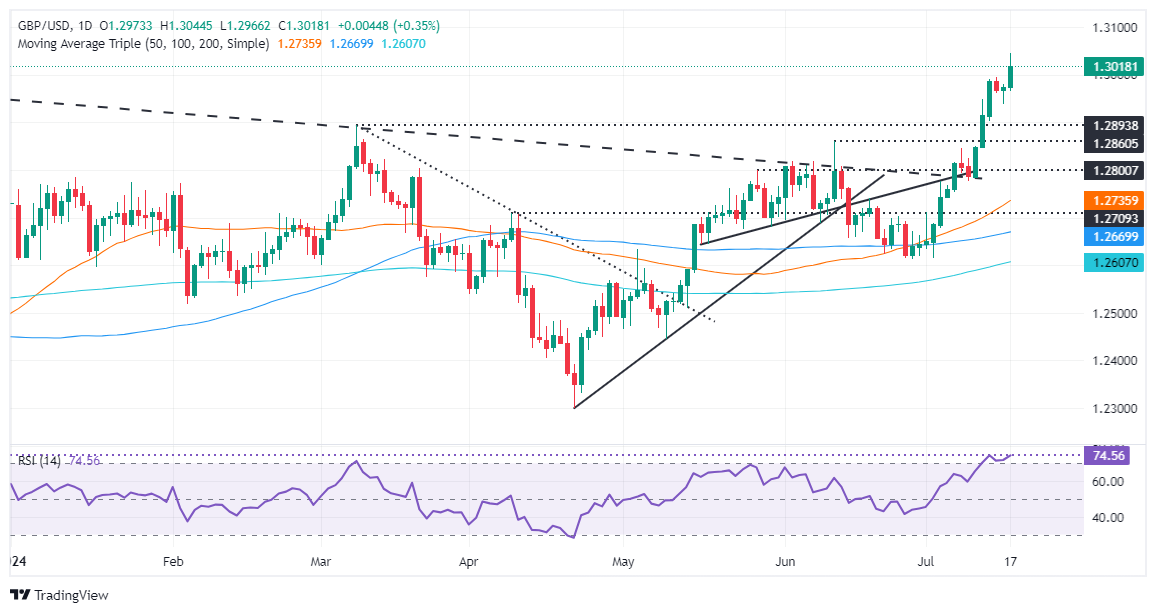- GBP/USD breaks above 1.3000 for the first time since July 2023.
- The RSI indicates strong bullish momentum, with potential targets at 1.3050 and 1.3100.
- Key supports are found at 1.2894 and 1.2860 if a pullback below the psychological level of 1.3000 occurs.
The British Pound has risen sharply, breaking above the 1.3000 level for the first time since July 19, 2023, and is trading at 1.3020, up 0.36%, following a mixed inflation report in the UK.
GBP/USD Price Analysis: Technical Outlook
The GBP/USD uptrend is set to continue if the rhetoric of Federal Reserve officials becomes more dovish as policymakers consider the first rate cut. The bullish momentum has picked up speed, as shown by the RSI, which, despite being overbought above 70, due to the strength of the trend, most traders see the 80 level as the most extreme condition.
If GBP/USD breaks above the psychological figure of 1.3050, buyers could target the 1.3100 mark. They can further challenge key supply zones above, with the July 18, 2023 peak at 1.3125, prior to last year’s high at 1.3142.
On the other hand, a pullback below 1.3000 may exacerbate a deeper correction, with traders targeting the latest cycle high, which turned into support at 1.2894, the daily high of March 8. The next drop lies below, with the next demand zone at 1.2860 before a drop to the March 21 high of 1.2803.
GBP/USD Price Action – Daily Chart
The British Pound FAQs
The Pound Sterling (GBP) is the oldest currency in the world (886 AD) and the official currency of the United Kingdom. It is the fourth most traded currency unit in the world, accounting for 12% of all transactions and an average of $630 billion a day, as of 2022.
Its key currency pairs are GBP/USD, also known as the “Cable,” which accounts for 11% of the forex market, GBP/JPY, or the “Dragon” as it is known to traders (3%), and EUR/GBP (2%). The British Pound is issued by the Bank of England (BoE).
The most important factor influencing the value of the British Pound is the monetary policy decided by the Bank of England. The Bank of England bases its decisions on achieving its main objective of “price stability”, i.e. a stable inflation rate of around 2%. Its main tool for achieving this is the adjustment of interest rates.
When inflation is too high, the Bank of England tries to contain it by raising interest rates, making credit more expensive for individuals and businesses. This is generally positive for the GBP, as higher interest rates make the UK a more attractive place for global investors to park their money.
When inflation is too low, it is a sign that economic growth is slowing. In this scenario, the BoE will consider lowering interest rates to make credit cheaper, so that companies borrow more to invest in growth-generating projects.
The data released gauges the health of the economy and can influence the value of the Pound. Indicators such as GDP, manufacturing and services PMIs, and employment can influence the direction of the Pound.
A strong economy is good for the British Pound. Not only does it attract more foreign investment, but it may encourage the Bank of England to raise interest rates, which will directly strengthen the British Pound. Conversely, if economic data is weak, the British Pound is likely to fall.
Another significant indicator for the pound is the trade balance. This indicator measures the difference between what a country earns from its exports and what it spends on imports during a given period.
If a country produces highly sought-after exports, its currency will benefit exclusively from the additional demand created by foreign buyers who wish to purchase these goods. Therefore, a positive net trade balance strengthens a currency and vice versa for a negative balance.
Source: Fx Street
I am Joshua Winder, a senior-level journalist and editor at World Stock Market. I specialize in covering news related to the stock market and economic trends. With more than 8 years of experience in this field, I have become an expert in financial reporting.








